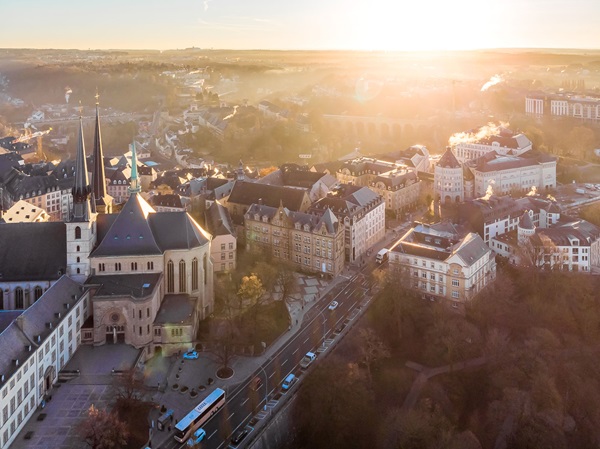 Credit: UBS
Credit: UBS
According to the UBS Global Wealth Report 2024, Luxembourg is leading the world in median wealth per adult, reflecting the country's upward wealth mobility and solidifying its position among the wealthiest nations globally.
On Monday 22 July 2024, UBS noted that in 2023 wealth growth across the world has recovered from its 3% contraction the previous year. The contraction in 2022 was largely attributable to currency effects, i.e. a strong USD. However, the bounce back of 4.2% offset the loss from 2022, regardless of whether it is expressed in USD or local currencies, and was driven by growth in Europe, the Middle East and Africa (EMEA) at 4.8%, as well as Asia-Pacific (APAC) at 4.4%. Moreover, as inflation slowed, real growth reportedly exceeded nominal growth in 2023, resulting in inflation-adjusted global wealth growing by nearly 8.4%.
Although global wealth has been on a steady upward trajectory since 2008, the pace of growth has lost steam in almost all markets. The latest edition of the Global Wealth Report, now in its fifteenth year, highlights a number of regional and demographic themes.
In 2023, adults in EMEA were the wealthiest on average ($166,000), followed by APAC ($156,000) and the Americas ($146,000). However, their average wealth grew at the slowest pace since 2008, increasing by around 41% compared to 122% in APAC and 110% in the Americas during the same period.
Overall wealth has grown fastest in APAC, rising by nearly 177% since 2008. This growth has been accompanied by a significant increase in debt, which has grown by over 192% in the same timeframe.
Although the Americas have trailed the global wealth rebound in 2023, the United States has bucked the trend of slowing growth over time. The US increased its compound annual growth rate from 4% between 2000-2010 to 6% between 2010-2023.
Negative wealth growth in USD between the start of the second decade and 2023 has only been found in Greece, Japan, Italy and Spain.
On an individual market level, Switzerland continues to top the list for average wealth per adult, followed by Luxembourg, Hong Kong SAR and the United States.
The biggest wealth increases in 2023 occurred in Turkey, Qatar and Russia, with Turkey leading at a staggering growth rate of 157%.
Presently, the United States, followed by Mainland China and the UK, have the highest number of USD millionaires, with the US accounting for 38% of global millionaires. By 2028, the number of adults with wealth of over USD one million is expected to rise in 52 of the 56 markets analysed, with an estimated 50% growth in Taiwan.
While average wealth is significantly higher than median wealth in almost all markets included in the report’s sample, countries such as the United Arab Emirates, Germany, Switzerland, Israel and Mexico have shown stronger growth in median compared to average wealth since 2008. This indicates that adults in lower wealth brackets have seen their wealth increase faster than those in higher brackets.
Although inequality has tended to increase over the years in fast-growing markets, it has diminished in several developed mature economies, the report found. Globally, the number of adults in the lowest wealth bracket is in constant decline, while all other brackets are steadily expanding.
In 2023, Switzerland and Luxembourg were in the top 25 countries in average wealth per adult (USD), whilst Luxembourg retained its 2022 position in 2023 as well as the top country in the top 25 in median wealth per adult (USD).
According to the report, across every wealth bracket and over any time horizon, it is consistently likelier for people to climb up the wealth ladder than slip down it. The analysis shows about one in three individuals moves into a higher wealth band within a decade and over a thirty-year timespan the chance of escaping the lowest wealth bracket rises to over 60%.
Finally, roughly $83 trillion is expected to be passed on within the next two decades. That is roughly the equivalent of the value of all the economic activity in the global economy in a single year. An under-explored facet of this transfer is that a notable amount of this wealth will move horizontally between spouses first, before moving to the next generation. In practice, this means a considerable transfer of wealth to women, considering their comparatively higher life expectancy.
Just over 10%, about $9 trillion, of the great wealth transfer are expected to be passed on horizontally first, most of it in the Americas.
Iqbal Khan, Co-President of UBS Global Wealth Management, said: “Wealth needs careful stewardship and managing it properly needs time, dedication and passion. As the world’s only truly global wealth manager, we understand the shifts and changes in global and local wealth and translate this into opportunities and outcomes for our clients.”
Robert Karofsky, Co-President of UBS Global Wealth Management, added: “Backed by 30 years of data, the Global Wealth Report crafts a clear picture of how wealth is created, how it’s distributed, how it transforms and how it’s transferred. It gives us deep insights and understanding that we can bring to fruit for our clients.”
Paul Donovan, Chief Economist at UBS Global Wealth Management, noted: “The world economy is embarking on a period of profound structural change. Such episodes often create significant changes in wealth patterns. At the same time, wealth is needed to finance the investment in both technology and people that will allow humanity and the planet to thrive in the brave new world. Knowing where and how wealth is held is essential to mobilising it effectively.”








